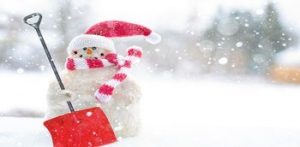Snow Removal Tips

It’s that time of year when the snow shovel comes out more often than not. Unfortunately, shoveling snow poses more of a health risk than you might think. Here are some safe snow shoveling practices:
Know your limitations:
- Do not overexert yourself: Your body is working hard to stay warm, so be careful not to work too hard. Some people are more at risk: smokers, those with a history of heart disease or high blood pressure and those that lead an inactive lifestyle. Check with your doctor if you have any concerns.
- Look into alternatives: Snow shoveling can be good exercise, but if you have been inactive or have certain risk factors, consider alternatives to shoveling like using a snow blower or hiring services that are equipped to do this.
- Use proper lifting techniques: Use your legs, not your back. Keep the shovel close to your body, and avoid any twisting motion.
- Handle only what you can lift: Snow can be heavy! It can sometimes weigh as much as 15 lbs. per cubic ft. Only handle an amount of snow within your capabilities. Use a small shovel to avoid lifting large amounts at one time.
- Take frequent breaks: Take a break every 5 or 10 minutes while you’re working.
- Don’t ignore chest pain or tightness: If this kind of ache occurs, assume the worst and call 911.
Before you begin:
- Warm up: Stretch the muscles in your back, legs, shoulders, and arms prior to starting. Warm muscles work more efficiently and are less prone to injury.
- Drink water: Typically, people shovel snow in the morning when they’re dehydrated. Dehydration is a stress to the heart. Drink a couple glasses of water about thirty minutes before you start. Stay hydrated throughout all work periods.
- Avoid caffeine and smoking: Caffeine and nicotine are stimulants which could increase your heart rate and place more stress on your heart.
- Dress in layers: Putting on a heavy coat is often done prior to starting this task. This is potentially dangerous because you may quickly overheat, which can put additional strain on your heart. Wear a shirt under a sweater, under a light jacket, and strip off layers as you warm up.
- Cover your face and hands in extreme cold: Frostbite can occur easily in subzero temperatures, particularly to the extremities. Ensure that your fingertips are fully covered with gloves, wear layered socks under your boots and cover your nose and ears. Use sunscreen due to increased reflective exposure from the snow.
- Slip protection: Wear anti-slip and supportive shoes, or wear shoe grips attached to the base of the shoes to prevent slips. Be aware of icy areas that may be hidden below the snow layer.
- Follow all manufacturers’ instructions on your snow blower.
- Always turn off the engine on a gas machine or unplug the motor on an electric model before clearing a clog at the auger or discharge chute and remember to use the clearing tool; not your hands for clogs.
- Protect yourself from carbon monoxide poisoning by starting and running gasoline-powered snow blowers outside, rather than in your garage, shed or warehouse.
- Don’t wear loose pants, jackets, scarves or other clothing which can get tangled in a snow blower’s moving parts.
- Wear hearing protection, especially when operating gas-powered models.
- Wait until a gas model’s engine is cool before refueling. Never refuel while a snow blower is running.





